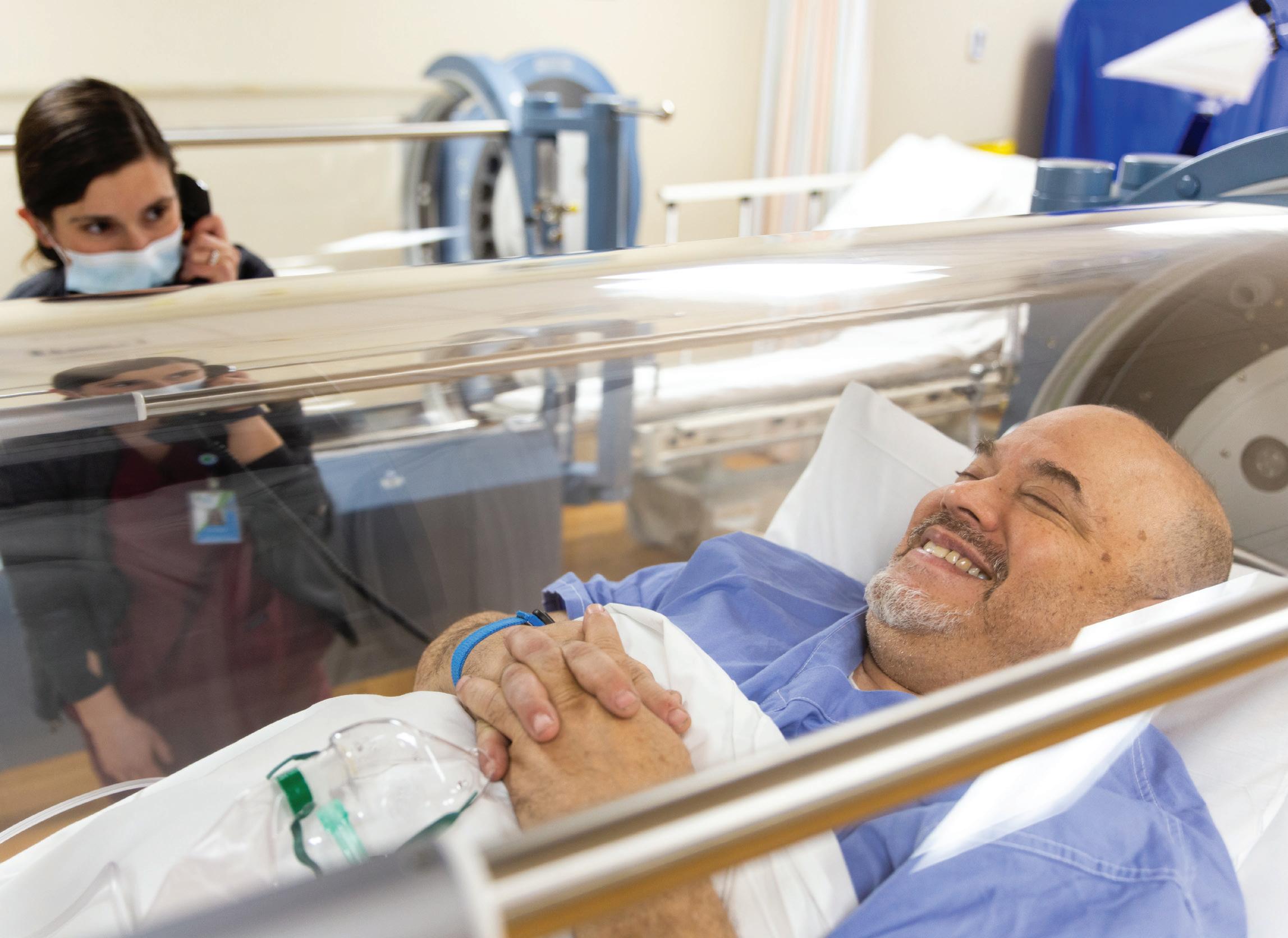
4 minute read
BEST FOOT FORWARD How intensive wound-care treatment can prevent amputation.
Rafael Perez talks with Ryanne Whalen, LPN, HBO Technician, while he is undergoing hyperbaric oxygen therapy at HMC's Wound Care Center.
BEST FOOT FORWARD
HOW INTENSIVE WOUND-CARE TREATMENT CAN PREVENT AMPUTATION.
APRIL IS FOOT HEALTH MONTH, making it the perfect time to remind everyone to be sure they’re taking good care of their feet. For people with diabetes, however, foot health should be top of mind daily. Diabetes can damage nerves in any part of the body, but most often impacts nerves in the feet and legs. Sometimes this damage causes symptoms, but other times it doesn’t, leaving affected people vulnerable to cuts, blisters or sores that go unnoticed and become serious.
“One of four people with diabetes develops a foot ulcer, and 40 percent of those with healed diabetic foot ulcers will develop a new one within a year,” says Ann Johnson, Program Director of Holyoke Medical Center’s Wound Care Center. “Daily self-foot exams and getting treatment early are key to healing challenging wounds. The longer a wound is open, the
SLOW TO HEAL
Last summer, Rafael Perez experienced this firsthand following a swim at the Daughters of the American Revolution State Forest lake in Goshen with his fiancée and her young daughter. “We had a great time,” recalls Rafael. “But a few days later, I became sick—shaking uncontrollably and spiking a fever.” A diabetic since his 20s, Rafael says he’s careful to protect his feet and was wearing water shoes.
Despite his precaution, an irritated area on Rafael’s right toe had become infected after exposure to the marshy lake. Rafael went to the Emergency Department at Holyoke Medical Center (HMC) and was admitted for antibiotic treatment. He remained there for one week. Francis Martinez, MD, used surgical debridement to remove the infected skin tissue and hasten healing. “Dr. Martinez was concerned that my toe wasn’t healing,” recalls Rafael. “We were worried I might need an amputation.”
In 2017, Rafael had a diabetic foot ulcer that was treated successfully with hyperbaric oxygen therapy (HBOT) at HMC’s Wound Care Center. Determined not to undergo an amputation this time, either, Rafael was eager to try HBOT again.
“When Rafael came to us in August, he was suffering from toe pain and was unable to walk,” says Maureen Pendergast Fuller, PA, of the HMC Wound Care Center. Fuller works alongside Savitri Rambissoon, MD, a general surgeon, certified wound care specialist and Medical Director of HMC Wound Care. “Rafael’s MRI showed gas gangrene associated with the wound, which carries a particularly high risk of nonhealing,” says Dr. Rambissoon. He had what’s classified as a grade 4 Wagner diabetic foot ulcer with exposed muscle and tendon, making HBOT appropriate for him.
AWARD-WINNING CARE
The HMC Wound Care Center has been recognized five times as a Center of Distinction by Healogics, the company partnering with HMC to manage the Center. “We have quality outcomes that include healing 82 percent of wounds for patients,” says Johnson. “We’re the only wound care center in our area to consistently achieve this award.”
The HMC Wound Care Center has two state-of-the-art hyperbaric oxygen chambers. HBOT surrounds the body with 100 percent oxygen at a pressure 1.5 times greater than normal air pressure—equivalent to diving down 50 feet in seawater. This treatment helps heal chronic conditions, including diabetic foot ulcers and circulation ulcers, chronic bone infections, trauma and damage from radiation. HBOT accelerates the body’s healing process by increasing the amount of oxygen in the blood.
Rafael participated in 60 “dives,” receiving one 90-minute treatment daily for 60 days. He continued antibiotics and had dead tissue debrided by Fuller at the clinic.
“After the initiation of HBOT, we began to see signs of improvement,” Fuller says. “More and more healthy tissue began to grow in the wound, which eventually led to complete healing.”
Patients receiving HBOT lie in a chamber on a stretcher with a television mounted on top to pass the time and help them relax. An HBO technician is nearby throughout the treatment. Rafael says the staff at the HMC Wound Care Center made his experience a comfortable one. “I’d watch TV or fall sleep,” Rafael says of his time in the chamber. He was surprised at the quick results. “You could see my toe healing.”
SUCCESS STORY
Fuller describes Rafael as an HBOT success story. “He escaped toe amputation after a very serious infection associated with a diabetic foot ulcer. He participated in all aspects of our care plan, followed our instructions and had the best outcome we could hope for.”
Remarking that HBOT is not for everyone, Fuller says: “It carries some risk, which is weighed carefully and individually for each patient. We follow Medicare guidelines and obtain insurance approval for patients to receive advanced therapies. In addition to diabetic foot ulcers, we have had success treating osteonecrosis of the jaw and cystitis associated with radiation exposure for cancer patients.”
After being off his feet for so many months, Rafael has returned to work as a driver for Autopart International. He says he’s happy to get back to life again and looks forward to a summer of swimming and fishing for bass and trout. “I’ll be careful!” Rafael promises.
Francis Martinez, MD Savitri Rambissoon, MD Ann Johnson, Program Director Maureen Pendergast Fuller, PA
✱For more information about hyperbaric oxygen therapy (HBOT) or other advanced wound care treatments, call the HMC Wound Care Center at 413.535.4740.






